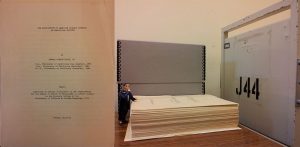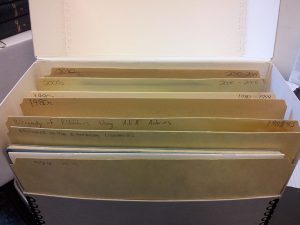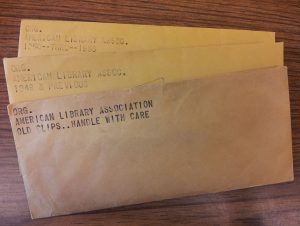One method for searching an institutional or organizational archives is through a review of publications about the organization. Some external publications capture ephemeral information about an organization and complement other archival information. Such formal or informal publications can be produced by the organization, by institutions, by groups, or by people. Read on to see some examples of what an archives may hold in a Record Group 0!
Record Series 0/2/2 is “Dissertations, Theses and Papers”. This series contains bound or unbound copies of dissertations, theses, and papers, written by students on the American Library Association, affiliated associations, organizations, divisions, round tables, or library science.
Some of the dissertations or theses can be found in scholarly databases or in institutional repositories; however, some may not. In particular, course papers are often difficult to locate because students discard their materials after a course has ended. Sometimes, course papers may provide evidence of course discussions, instructor comments, or guest speakers which may not be recorded anywhere else.
This implies our first research tip: course materials may provide citations or reference to otherwise unrecorded ephemeral information.
Record Series 0/3/2 is “Publications Based on A.L.A. Archives Research”. This series contains articles, bibliographies, books, book chapters, and journal essays that have used material from the A.L.A. Archives or A.A.L.L. Archives, includes correspondence from Mark Tucker, Basil Stuart-Stubbs, Dawn Haggblom, and a signed book for A.A.L.L. Archives Staff from Richard A. Danner.
While some of these publications are available in scholarly subscription databases online, there are other publications like library magazines and a religious institution’s newsletter which include library history research too. Copies of those publications may not be found elsewhere. It is not unusual for some archives to carry some external publications, although such materials may be outside of the archives’ collection scope.
This is another research tip: careful researchers know that not all bibliographies or databases scope overlap, and researchers do themselves a favor by checking each resource systematically.
Record Series 0/3/3 is “Non-ALA Publications about Librarianship”. This series contains books, brochures, conference flyers, publications, catalogs, bulletins, journals, newsletters, pamphlets, and reports produced by organizations not affiliated with the A.L.A., such as commercial publishers, (regional or state) libraries and library associations, the federal government, library clubs, and other national agencies and associations, such as the Special Libraries Association. Also, this record series has a folder of foreign language publications about children’s literature, including German and Russian. (Imagine what else is waiting to be read in this series!)
What makes this record series especially fun to browse is the diverse selection of publications co-sponsored or independent of the A.L.A. For example, a folder of commercial catalogs for businesses with library clients provide a unique view into how businesses perceive and market goods or services for libraries and librarians. In fact, at least one business has used material from the A.L.A. Archives for magazine advertisements.
This is a third research tip: commercial catalogs are specialized resources of information on libraries and librarianship, not to be overlooked.
Record Series 0/3/10 is “Newspaper Clippings”. This series contains newspaper clippings and photocopies of newspaper clippings from Harper’s Weekly, Ithaca Journal, New York Times, Pioneer Press, San Francisco Chronicle, and San Francisco Examiner, on ALA activities, including meetings, policy statements, especially those dealing with annual conferences (1915, 1947, 1958).
This record series was transferred to A.L.A. Archives from the A.L.A. Library in a group of envelopes separated by decades. While it is small in size, it does underscore the recurring previous research theme above: not all historical publications are available in online databases currently. For many reasons, a publication may not be digitally accessible now or in the near future. Regardless how publications are accessed, another benefit of searching newspaper article collections is to observe the trends across publications (which may be available in isolation in a database).
This begs another research tip: newspaper articles can provide additional source material for thinking about external views of librarianship of the A.L.A. which are easily overlooked when discussing professional or scholarly issues.
Record Series 0/4/2 is “Public Relations Board, Inc., Evaluations”. This is a folder of reports from a consultant organization’s analysis and plans for developing an aspect of the American Library Association.
What makes this a valuable resource to researchers is the types of information which consultant reports contain. Sometimes, there are histories of departments and interview information from clients or employees. While such materials may not be publicly available at all archives, accessible consultant reports can help readers understand internal and external administrative perspectives of an organization, including contemporary professional or cultural challenges in a profession.
Next month, we will survey some of the publications of the American Library Association.





